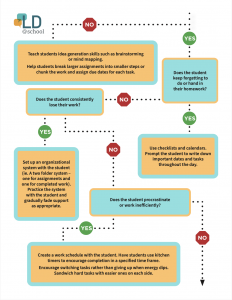 Add to favorites
Add to favoritesby Claire Ogden, Graduate Student, Master of Arts in Child Study & Education at the Dr. Eric Jackman Institute of Child Study, Ontario Institute for Studies in Education.
Assigning homework to students can be a great way to have them practice and apply their learning, finish incomplete classwork, and prepare them for the increasing demands of independent work as their academic career progresses. However, keep in mind that students with learning disabilities (LDs) commonly encounter more difficulties than their peers when it comes to working in the often less structured environment of home. While some students with LDs may ultimately require modification of homework assignments, in many cases this may be avoidable through working with the student and family to establish good, consistent homework habits, strategies and routines.
![]()
Students with LDs often have to work harder than other students to achieve the same results. Clearly, difficulties are likely to arise where homework concerns a topic or task directly impacted by their specific LD (e.g. assigning a reading passage to a student with decoding difficulties), but homework is also impacted by weaknesses in working memory, planning, self-regulation, attention and other executive functioning skills which are also prevalent amongst students with LDs. In the absence of tailored, appropriate support at home, homework is likely to be especially challenging for these students.
The first step in avoiding such difficulties is to ensure that assigned homework is appropriate and meaningful. This should be the case for all students, but especially for those with LDs who do not have access to the same special educational supports they benefit from at school, in the home setting. Although many parents and carers can offer valuable assistance, they should not be expected to replace the teacher at home. To be most constructive (for the purposes of both teachers and students), homework should be completed as independently as possible. As such, giving clear direction and setting reasonable expectations is also crucial to set up students for success. Where students regularly refuse, neglect or forget to hand-in homework in a timely/complete manner, first consider whether the homework is too lengthy, arduous and/or beyond the students’ current academic or cognitive functioning capabilities. Other signs to look out for include students complaining excessively about homework or consistently failing to study for tests and caregivers who report frequent problems or confrontation with regards to homework. Where homework has been assigned thoughtfully, and problems continue to occur it can be helpful to meet with students and their caregivers to discuss potential homework strategies.
A Plan That LASTs
When it comes to homework, consistency is key. Predictable schedules help homework run more smoothly, foster a sense of reassuring order in students and help students better understand expectations. Begin by encouraging families to use the LAST formula to establish a realistic homework routine that will hopefully ‘last’ beyond their current grade.
LOCATION
Recommend that students identify the place outside of school where they work best: it may be a quiet space with no distractions or somewhere with easy access to help. They may work better with predictable background noise or music without words than complete silence. Some children may even work better if they are able to stand or move around/walk while doing activities such as reading, memorizing, or being quizzed. Encourage your student to discuss and experiment with different locations to establish where works best for them.
ALL SUPPLIES
Encourage caregivers to provide students with a clear workspace large enough to set out all required materials and equipped with all supplies their child is likely to need: pencils, pens, erasers, rules, scissors, calculator, glue, lined paper etc. depending on the age of the child. This may need to be portable. It can also be useful to acquire a bulletin board for keeping track of assignments. Allowing the student to decorate their space may be an added incentive (although make sure it is not too cluttered or full of distractions).
SCHEDULE
Students with executive functioning deficits could benefit from beginning each homework session by drawing up a schedule, making sure each assignment is understood and all necessary materials are available. Help your student to estimate the time each assignment will take and determine which parts they need help with. Families should agree upon a target finish time and schedule in breaks accordingly. This not only teaches the value of planning and time management but also helps to limit procrastination.
TIME
Press upon students and caregivers that it can be useful to get into the habit of doing homework at the same time every night. Some children need a break after school. Some prefer to get it done whilst in ‘school mode’. The later it gets, the more tired the child will become. Families should consider whether other times e.g. before school, could work better for them. The family should agree on a time to avoid conflict later.
Troubleshooting
Implementing the ‘LAST’ formula may be enough for some children, but it is also quite common for students with LDs to need more specific support. This Homework Trouble-shooter offers various tips and suggested interventions to some of the more common homework issues.



Click here to view and download the Homework Trouble-shooter
When formulating a support plan in cooperation with the family, this Homework Support Plan Template can help guide the discussion.

Click here to view and download the Homework Support Plan Template.
It is always helpful to properly define the issue and establish the desired outcome of any interventions before considering a range of solutions. Once a plan has been determined, further clarity and buy-in can be achieved by entering into a simple contract that outlines everyone’s agreed responsibilities.

Click here to view and download the Example Homework Contract.
Incentives
Some students may further benefit from incentivization, which works best when applied consistently. Effective school-home collaboration can facilitate a consistent approach so that students know what to expect and what is expected of them.
A simple incentive might be scheduling a fun activity to reward completion or submission of homework (e.g. extra recess, screen time or a favourite home/classroom activity) or building in breaks (either at 10 - 15 mins intervals or at the end of specific tasks). More elaborate incentives involve identifying a problem behaviour—what specific difficulty is the child having with homework (procrastinating, rushing, making careless mistakes, forgetting materials etc.) —writing a goal relating directly to the identified issue and listing rewards that can be earned for meeting criteria.
Points systems can be used to enable students to accrue points at school that can be traded for defined rewards at home. Menus of rewards tend to work best (for longevity). Systems that offer both small and larger (more expensive or long-term) rewards in exchange for points work well. Both material (e.g. small toys, snacks) and activity (e.g. chance to play with friends) age-appropriate reinforcers can be offered. If, after troubleshooting, all parties come to a mutual agreement on how homework should proceed, it may then be helpful to factor in penalties (usually a loss of privilege) for non-compliance. Any incentive schemes ought to be reviewed regularly. If the child seems to be earning more penalties than rewards, or has outgrown the incentives on offer, the plan has to be revised so that they are properly motivated and set for success.
Encouragement
Finally, it is often helpful to remind caregivers to:
- Focus on the positive aspects of their child’s work;
- Provide specific concrete praise (rather than ‘good job’, they can try, ‘I loved how you persevered when the questions got difficult’);
- Promote a growth mindset that rewards effort not innate abilities and celebrates mistakes; and
- Use ‘sandwich feedback’, where each piece of constructive criticism is sandwiched between two positive comments.
![]()
References:
Dawson, P. (2001). Homework: Problem and solutions. Smart but Scattered Kids.com: https://www.smartbutscatteredkids.com/wp-content/uploads/2018/03/Homework-Problems-Solutions.pdf








